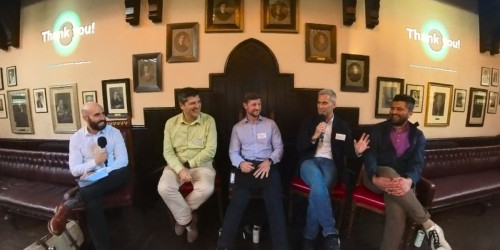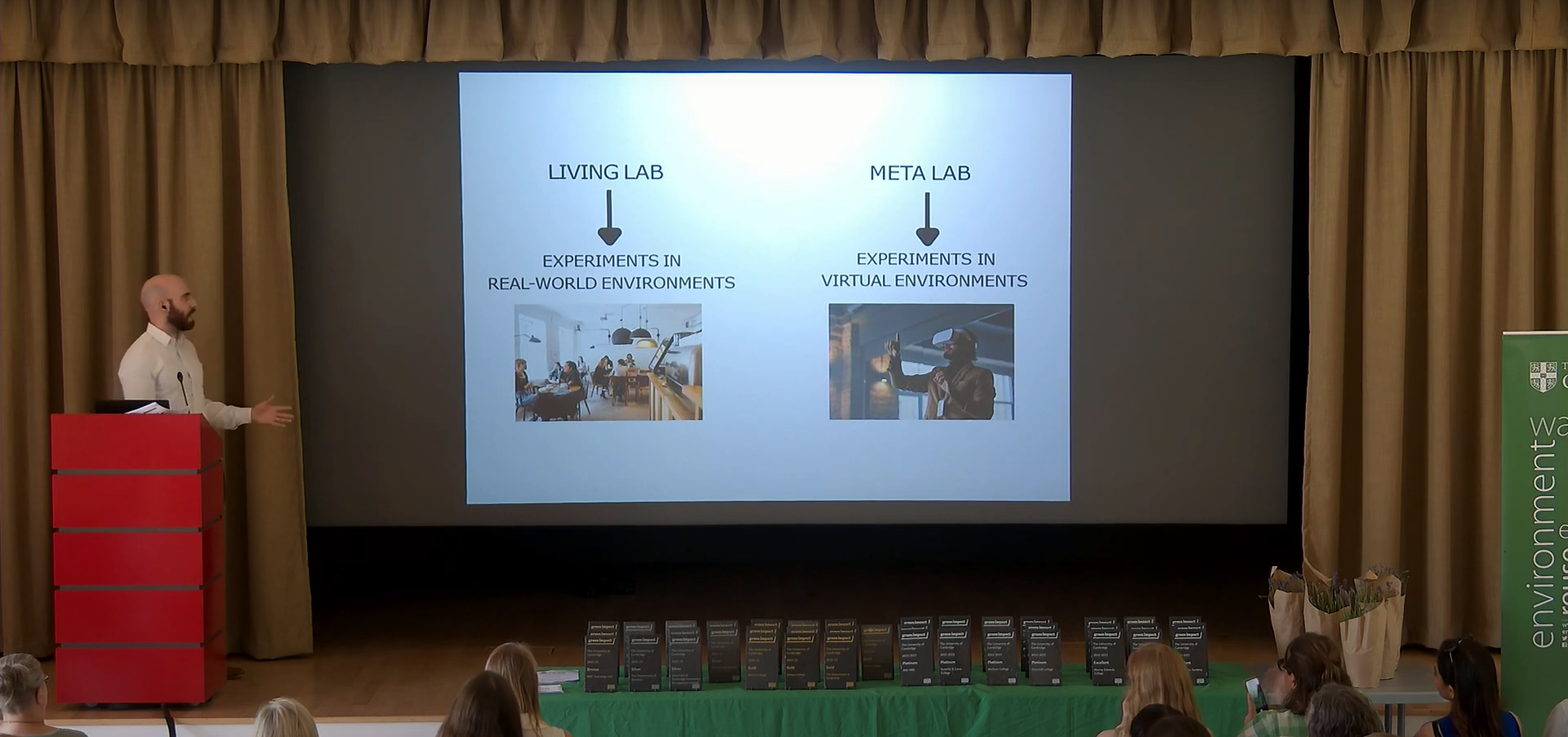
Dr Chris Macdonald speaks at the Cambridge Union
Lucy Cavendish Fellow, Dr Chris Macdonald, was part of the emerging tech panel at the Cambridge Climate and Sustainability Forum.
The College wins two awards for leading-edge sustainability research and is praised for its innovative dual-lab approach.
Lucy Cavendish Fellow and Lab Director, Dr Chris Macdonald, discusses the newly established labs and the awards they received at this year’s Sustainability Showcase.
What awards did you win?
Last year, Lucy Cavendish College won the Platinum Award for Green Impact which was thanks to the great progress made with infrastructure and procurement (e.g. our new building meets and exceeds the Passivhaus standard, and 100% of our electricity is supplied by renewables). Building on this positive momentum, I was keen for us to further innovate and also explore the behavioural side of the equation. In service of this, I established two labs which both received awards at this year’s Sustainability Showcase: the Excellence Award for research conducted in the Living Lab, and the Innovation Award for research conducted in the Meta Lab.
What is the Living Lab?
While some experiments may provide results within hypothetical scenarios and conventional lab environments, the resulting interventions might not be practical or effective when stress-tested by the realities of day-to-day life. A living lab seeks to address such concerns. It starts with a real-world setting, where the explored scenarios unfold, and it makes that the ‘lab’. Therefore, researchers can experiment in context, track results, and make adjustments as the projects evolve based upon the behaviour of ‘real people’ in ‘real places’. Accordingly, a living lab is a powerful tool for behavioural scientists to expand on prior theories and develop data-driven practical interventions.
What experiments have you been conducting in the Living Lab?
I have been exploring the effectiveness of green nudges: behavioural interventions that aim to increase pro-environmental choices. A key characteristic of a behavioural ‘nudge’ is that it relies on gentle guidance and support rather than regulation or prohibition. For example, banning sugar would not be deemed a mere nudge; displaying nutritional information on product packaging would be deemed a nudge.
So far, we have been exploring green nudges that relate to food and drink purchases. Accordingly, the Living Lab covers the College café and servery. We started by exploring ways to reduce single-use packaging by promoting the use of reusable containers through incentives and variations in choice architecture. We later experimented with displaying the relevant carbon emissions data on menus. These kinds of experiments wouldn't have been possible without the support of the College community—especially Catherine Kearsey who really went out of her way to support my research.
Outside of the Living Lab, I also trial potential green nudges in larger online studies to act as an idea incubator. Both online and field studies have their own distinct advantages and so I want to be sure that we benefit from both. The plan would also be to ‘sunset clause’ successful interventions so that we continue to remain informed by the latest scientific literature and further prevent status-quo bias as ‘new normals’ are established.
These are important additional steps for me as while a living lab is fitting of its name for the fact that it is part of a ‘living’ space with ‘living’ people, it can also be fitting of its name given that it can become a playground of ‘living’ interventions that continue to evolve in response to new information.
What is the Meta Lab?
In the Meta Lab, I conduct experiments in digitally-enhanced or virtual environments to develop immersive educational experiences and platforms. The idea was to build on the concept of a living lab by exploring beyond the limitations of the physical environment. The goal was to find practical applications for the latest advances in digital technology.
What have you explored in the Meta Lab?
The launch project was called ‘Making the Invisible Visible’. The project was a response to the fact that it can be challenging to communicate climate change to the general public: the terminology can be confusing, the way in which we measure emissions can be non-intuitive, and there is a range of complicated psychological barriers (e.g. present bias, availability heuristic, pseudoinefficacy). The danger is that climate change can appear distant, or worse still, non-existent. A key part of the challenge is that with the human eye, we cannot see the accumulation of greenhouse gases in our atmosphere. As a result, I wanted to leverage emerging tech to better translate and visualise emissions data; I wanted to try to make the invisible visible. Throughout the project, I have explored multiple technologies and approaches, such as creating dynamic infographics with animations and creating visual metaphors and analogies with generative AI. The most effective method involved the use of virtual reality. In particular, I translated emissions data into height and then used that to create 3D representations of emissions in metaverse environments and virtual classrooms. This not only helped to simplify and visualise the data, but it also helped to make it interactive where students could, for example, ‘climb the emissions’ of common items and products.
What’s next?
Lucy Cavendish College is a dynamic hub of pioneering researchers who are committed to making a positive impact on society. The College also does a fantastic job of bringing people together, nurturing an enterprising mindset, and supporting innovation. There is a palpable energy here which acts as a catalyst for a whole host of fascinating projects. And so, it is always exciting to think about what's coming next.
With regard to the newly established labs, there are some exciting projects in development. For example, in the Meta Lab, I am currently building a virtual reality public speaking platform where students can gain confidence through VR exposure therapy (VRET). On the free platform, students will be able to steadily build resilience through a self-paced gamified journey where the virtual audiences increase as tasks are completed. Early prototyping exceeded expectations and I’m now able to recreate any venue in virtual reality with photo-realistic quality. It has capacity to help at scale, especially those who experience severe social anxiety, which is at record numbers in the wake of the pandemic.
There is massive untapped potential with the latest advances in VR which are currently largely used for entertainment purposes. The new wave of emerging tech presents a fantastic opportunity to innovate and create deeply immersive life-changing educational experiences. This is not only a unique chance to think about the future of education. This is a chance to create it.
